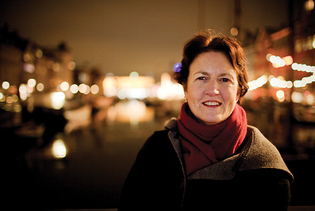
Anders Hansson/NRDC
Frances Beinecke
Environmentalist
By Dylan Walsh ’11MEM
Frances Beinecke ’71, ’74MFS, has traveled to the Arctic National Wildlife Refuge to see tundra still untouched by oil wells. She has been to Baja’s San Ignacio Lagoon, the refuge of migrating gray whales, where locals, activists, and experts fought off a move to build the world’s biggest salt factory. These are sites of hard-fought victory. She has also seen infernal stretches of Alberta tar-sands mining and poisoned waterways in Appalachian coal country. “You have to see this stuff—the good and the bad,” she says. “It makes you think: we should be doing more.”
For four decades, Beinecke worked at the Natural Resources Defense Council. She began as an intern in summer 1973, while a student at what is now the Yale School of the Environment. Upon graduation, she joined full-time, eventually becoming executive director in 1998. In 2006, she became the second president in NRDC’s history.
She was as prepared as anyone could be for the job, but there is a difference between being number two in an organization and being number one. “That first day as president you walk in and go, Okay, now it’s me,” she says. She had tremendous support from staff and board, but the well-being of the organization, of everybody who worked for it and donated money and time to it, ultimately rested on her decisions, her guidance, her intuitions. “During that almost ten-year period, the weight of this sat with me every day.”
For most of Beinecke’s tenure, Barack Obama occupied the White House. And though she regrets that strategic missteps led to the collapse of 2009 climate legislation—“you always have regrets”—she was generally hopeful during that period. Obama’s administration enacted stringent car emissions standards. He adopted the Clean Power Plan to curtail carbon emissions from the electric-power sector. The US reestablished a position of environmental leadership among international peers. Having steered NRDC for almost a decade, Beinecke stepped down in early 2015 with the fragile conviction that the US, after a long political winter, was finally accelerating on the right and necessary environmental trajectory. Then came November 2016.
“In the climate arena, we are in very, very serious trouble,” she says, and the Trump administration has worsened it, in part by reversing decades of environmental regulatory progress. The Environmental Protection Agency—previously led by a man Beinecke has described as intent on dismantling it—now has a successor who, she says, is no better.
For Beinecke, these attacks on the environment are a call to action, and she’s heartened to see that she is not alone in this feeling. The social tumult of today reminds her of her time in college, when Martin Luther King Jr. and Robert Kennedy were assassinated; when the anti-war movement reached fevered and sometimes violent heights; when an oil spill dumped three million gallons of crude into the Pacific and sullied 35 miles of California coastline. History moves in cycles, Beinecke says. Here we are again.
“I am hopeful that the better part of the human spirit will rise, not only here in the US, but worldwide, because a malaise has fallen over the whole planet,” she says. “We have a lot of work to do.”
 loading
loading